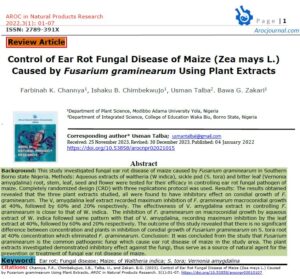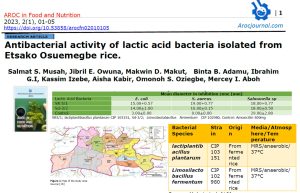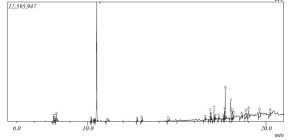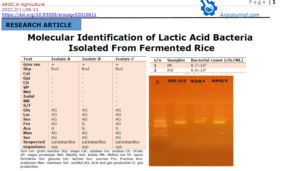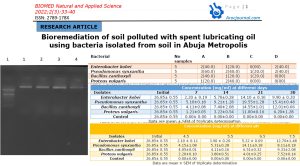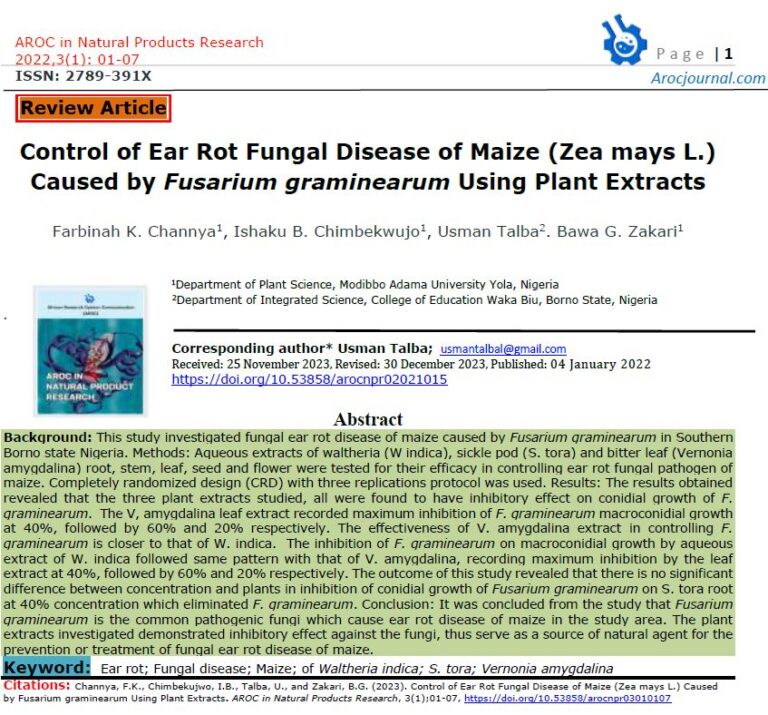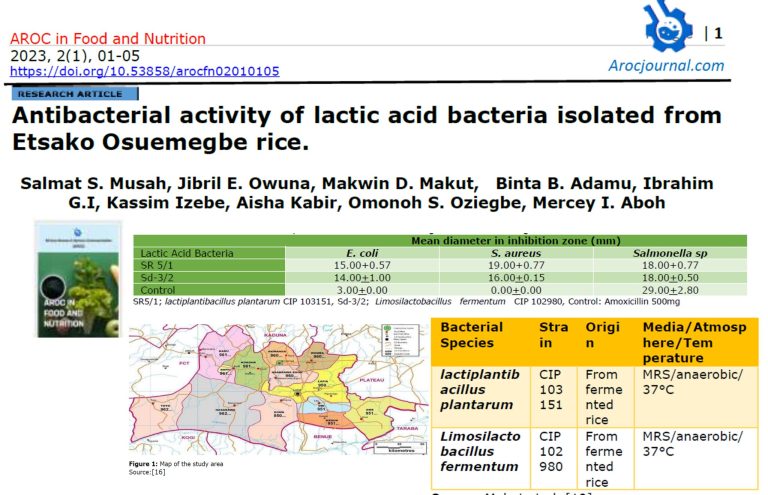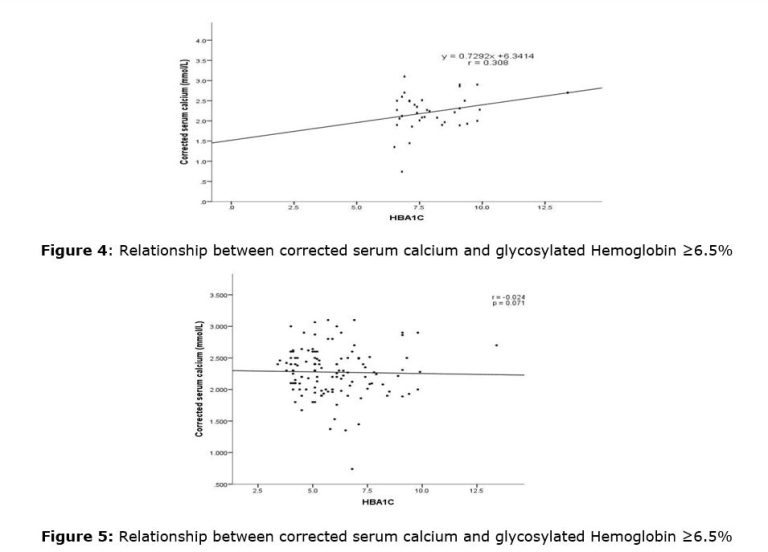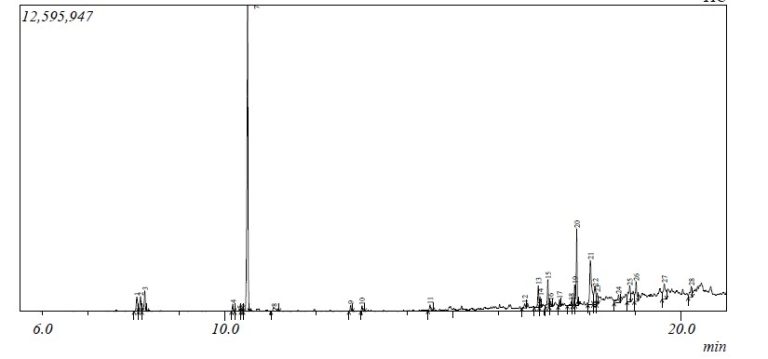1.0 Introductions
Proteases (EC 3.4) also referred as peptidases or proteinases are the hydrolase enzymes which have small size, compact molecules, spherical structures and are capable of hydrolyzing peptide bonds in the primary structure of proteins and peptids [1]. They are used to cleave the proteins specifically to produce useful peptides in the processes [2].
Proteases are one of the most important group of industrial enzymes and account for nearly 60% of the total enzyme sale [3]. They are generally used in detergents, food industries, leather, meat processing, cheese making, silver recovery from photographic film, production of digestive and certain medical treatments of inflammation and virulent wounds [4]. They also have medical and pharmaceutical applications.
Proteolytic enzymes are ubiquitous in occurrence, being found in all living organisms, and are essential for cell growth and differentiation. The extracellular proteases are of commercial value and find multiple applications in various industrial sectors. Although there are many microbial sources available for producing proteases, only a few are recognized as commercial producers [5]. Of these, strains, Bacillus species dominate the industrial sector [6]
Bacillus megaterium is an important family of gram positive bacteria, members of this family comprise substantial proportion of the micro flora of free living saprophytes in soil, fresh water, marine environments and many other natural habitats [7]. Primarily a soil bacterium, B. megaterium is also found in diverse environments from rice paddies to dried food, seawater, sediments, fish, normal flora, and even in bee honey [8]. Taxonomically, B. megaterium is placed into the B. subtilis group of Bacilli although there is only a small degree of relation in the genome structure between B. megaterium and B. subtilis. B. megaterium is able to grow on a wide variety of carbon sources and has, thus, been found in many ecological niches, such as waste from meat industry or petrochemical effluents [8].
Utilization and recycling of renewable resources that pose threat to the environment can be systematically carried out to bring about resource productivity needed to make human activity sustainable [9]. Nigeria is an agro based country that produces large quantities of agro industrial residues which are rich in nutrients like carbon, nitrogen, minerals, and biomass residues [10]. These agricultural wastes can be used as substrate for enzyme production owing to economic feasibility, as it can help in solving pollution problems which may be caused by their disposal [11, 12] The aim of this research is to produce and characterize protease by Bacillus magaterium using mango seed kernel and pineapple peel as carbon source
2.0 Materials and Methods
2.1 Reagents
Nutrient agar, glycerol, glucose, peptone, casein, anhydrose magnesium sulphate, potassium hydrogen phosphate, anhydrose iron sulphate, glyceline sodium hydroxide buffer, trichloroacetic acid, alkaline copper reagent, folins reagent, Bradford reagent, citrate buffer, phosphate buffer, tris-HCl buffer,
2.2 Microbial Culture
The culture of Bacillus megaterium used was obtained from Center for Genetic Engineering of Federal University of Technology Minna. Stock cultures were maintained in nutrient broth medium with 70% glycerol, cultures were preserved in a refrigerator. A loopful of bacterial strain (Bacillus megaterium) were transferred to a tube of sterile nutrient broth and allowed to grow overnight at 37 ºC before being used for inoculation.
2.3 Collections of mango seed and pineapple peels
Fresh mango was bought from Minna fruit market by March 2016, the seeds were broken and the content were sun dried, ground to fine mesh size and stored in plastic jars. Fresh pineapple peels were collected from fruit vendors at peeling points from Minna fruit market. The peels were washed with tap water to remove debris after which they were blended.
2.4 Proximate Analysis of Mango Seed and Pineapple Peels
The proximate compositions including; crude proteins, crude fibre, moisture content, ash content, crude fat and carbohydrate contents of both mango seed kernel and pineapple peels were determined using standard procedures described in previous studies [13-15].
2.5 Antibacterial Activity of Mango Seed and Pineapple Peel Extract
The substrates were subjected to antimicrobial evaluation against five organism including B. megaterium, B. subtilis, Pseudomonas aeroginosa, Staphylococcus aureus, Aspergillus niger and as described previously [16-19]. Nutrient Agar was prepared in conical flask in accordance to the directions provided by the manufacturer. The media along with petri dishes, pipette and metallic borer were sterilized in autoclave for 15 minutes at 121oC and 15 psi pressure. The media was poured into petri dishes under aseptic condition. The stock solutions of corresponding extracts were prepared in distilled water. Bacterial strains were innoculated on the solidified agar media, 7 mm wells were punched in the agar media by using sterile metallic borer. Stock solutions of crude extract in distilled water at concentration of 20 mg/mL were prepared and 200 μl from each stock solution was added into respective wells. The petri dishes were incubated at 37oC for 24 hours. After 24 hours antibacterial activities were measured as diameter of the zones of inhibition.
2.6 Protease Production
Protease enzyme production was carried out using standard media glucose, 0.5%(w/v), peptone, 0.75%(w/v), salt solution, 5%(v/v)-{MgSO4.7H2O, 0.5% (w/v), KH2PO4 0.5% (w/v),} and FeSO4.7H2O, 0.01% (w/v) on a shaker incubator at 160rpm(37oC) for 48hours. The culture medium was harvested and was subjected to centrifugation at 10,000rpm for 20min to obtain crude protease extract which served as enzyme source.
2.7 Determination of Enzyme Activity
Protease activity of the crude extract was determined by the protease activity method using L-Tyrosine (0-1000 mg/L) as the standard. L-Tyrosine standards were prepared in different concentrations and the standard calibration curve was obtained. Total protein activity was calculated from standard calibration curve. Protease activity of the crude extract was determined according the following steps. 100 μl 0.5% (w/v) casein in 50µM Glycine NaOH buffer pH 10.0 was added to 100 μl enzyme solution and the assay mixture was incubated for 10 minutes at 55 ºC in the water bath. 3ml 10% TCA in deionized water was added to enzyme-substrate solution to terminate the reaction, the mixture was centrifuge for 15 at 10,000rpm. 1ml of filtrate was mixed with 5ml of alkaline copper reagent and after 15min, 0.5ml of Folin-ciocalteu’s reagent was added, up on standing for 30min. The absorbance was read at 700nm. Similarly, blank was carried out by replacing enzyme with distilled water. 0ne unit of enzyme activity is defined as the amount of enzyme that releases 1µg of tyrosine per ml per minute under the same assay conditions [20-21]
2.8 Effect of different carbon sources on protease production
We evaluated the effect of different carbon sources on protease productionGlucose was replaced with mango seed and pineapple peels juice at various concentrations of 0.5g, 1.0g, 1.5g, 2.5g, 7.5g and 10.0g respectively.
2.9 Statistical Analysis
In all experiments, the measurements were carried out with triplicate parallel cultures. The values reported are means ± S.D. The results were analyzed by analysis of variance using statistical software IMB SPSS Statistics 22.
3.0 Results
3.1 Proximate composition of mango seed kernel and pineapple peels
Mango seed kernel has low moisture, ash and crude fibre content but has high oil and crude protein content. Pineapple peels has high moisture and fibre content but low in ash, crude protein and oil content (Table 1).
Table 1: Proximate composition of Mango seed kernel and pineapple peels

3.2 Anti-Microbial Activity of Mango Seed Kernel Extract
Mango seed kernel extract was tested against some industrial based microbes. The result shows that mango seed extract is sensitive against B. subtilis, less sensitive to B. megaterium and no activity against A. niger (Table 2).
Table 2: Anti-Microbial Activity of Mango Seed Kernel Extract

3.3 Anti-Microbial Activity of Pineapple Peel Extract
Pineapple peel extracted was tested against some industrial base microbes. The result shows it is highly sensitive to B. subtilis and S aureus but slightly sensitive against B. megaterium. It shows no activity against P. aeroginosa and A niger (Table 3).

3.4 Effects of Different Carbon Sources on Protease Production.
The extracellular protease enzyme was synthesized by Bacillus megaterium. The results obtained in this work revealed the ability of Bacillus megaterium to produce extracellular protease. Figure 1 shows the ability of B. megaterium to utilize glucose, mango seed kernel and pineapple peels as a carbon source and energy material to produce protease enzyme. Interestingly, the results indicated that B. megaterium exhibited their maximum ability to biosynthesize protease when grown on mango seed kernel.

Figure 1: Effects of Different Carbon Sources on Protease Production. Results are mean of three independent determinations. Error Bars correspond to standard error of mean.
3.5 Effect of Different Carbon Source Concentration on Protease Production.
Different substrate (glucose, mango seed kernel and pineapple peels) concentrations were applied to investigate their effect on protease productivity by Bacillus megaterium. Figure 2 indicated that the maximum productivity was attained when mango seed kernel was used as carbon source at all tested concentrations.

4.0 Discussion
High carbohydrate content of both mango and pineapple peels can serve as essential carbon source for microbial growth. This high carbohydrate content can stimulate expression of many hydrolytic enzymes, protease inclusive. The amount of enzymes produced by a microorganism depends on the amount of carbon sources available and utilized by the producing organism. The protein content of both mango seed and pineapple peels can serve as essential nitrogen source for normal microbial growth and metabolism. The high protein content of this agro wastes used for enzyme production can elicit the secretion of protease enzyme in the fermentation media.
The ash contents of both mango and pineapple peels is relatively low. Low ash is usually an indication of low inorganic mineral content [22]. According to the study of Fowomola, [23], Mango seed kernel was found to be high in potassium, magnesium, phosphorus, calcium and sodium. Potassium is an essential nutrient and has an important role in the synthesis of amino acids and proteins [23]. Calcium and magnesium play a significant role in photosynthesis, carbohydrate metabolism, nucleic acids and binding agents of cell walls [24].
The moisture content of mango seed was considerably low compared to that of pineapple. The high moisture content of pineapple peels will make it suitable for submerge and solid state fermentation. The reduced moisture content in the mango seed is an indication that their shelf life would be prolonged and that deterioration due to microbial contamination would be limited [25]. The pineapple peels has higher fibre content than mango seed. The high crude of pineapple compensates for its low carbohydrate content and can also serve as carbon source for microbial growth. Most microorganisms have enzymatic mechanism to hydrolyze lignocelluloses (fibre). Mango seed is rich in fat than pineapple peels. The high fat can also serve as carbon source for microbial cultivation in the absence of carbohydrate. Mango seed can also serve as substrate for microbial lipase production. The fat content of mango seed can also be utilized for industrial biodiesel production.
The microbial strains used to screen the possible antimicrobial activity of mango seed pineapple extract are based on their industrial application [26]. Interpretation of inhibition zones of test culture was adopted from Johnson and Case [27]. A zone of inhibition is an area around the point in the media where the test sample is introduced and where no test organisms (pathogenic bacterial strains) are found to be growing. A diameter of zone of inhibition of 10 or less indicates the test product being resistant to the test organisms (pathogens), diameter zone of inhibition of 11 to 15 indicates the test product having an intermediate resistant to the test organisms. A diameter with a zone of inhibition of 16 or more indicates that test product is highly resistance to test organisms. Pineapple peels extract was also not active against P. aeroginosa but was sensitive to B. sutilis from concentration of 0.12g/ml and above. The activity of mango seed kernel extracts on B. megaterium was not significant but highly sensitive to B. subtilis. The two extract were sensitive to S. aureus at all concentrations tested. Mango seed extract was also active against P. aeroginosa at all tested concentrations. Both mango seed kernel and pineapple peel extracts did not show any activity against A. niger.
There are general reports showing that different carbon sources have different influences on extra cellular enzyme production by different strains [26].The effect of the different carbon sources on growth and enzymatic production on sub-merge fermentation was studied by growing the microorganism in a medium containing different carbon sources including agriculture wastes. Most of the proteases of microbial origin are extracellular and excreted through the cell membrane into the culture medium consisting of a suitable substrate. Among all the substrates tested for protease production, mango seed holds the best capacity for protease production by B. megaterium (Figure 1), which indicates that it contains all the basic nutrients for bacterial growth and protease production. Mango seed proves to be a good protease producer because it is rich in protein contents than any other source used in the present study. Pineapple peels are mainly composed of carbohydrates with little protein contents and is a rich source of insoluble fibre.
The standardization was carried out by varying the level of substrate i.e. glucose, mango seed and pineapple peels from 0.5 to 10 g per 200ml of culture medium. Protease production in glucose enriched media was optimal at 2.5g/100ml of incubation media, mango at 1.5g/100ml of incubation media and pineapple was at 2.5g/100ml of incubation media was synthesized by B. megaterium. (Fig. 2). Results revealed that protease production per gram dry carbon was increased by increasing the amount of substrate. This might be due to increase in nutrient composition of culture media.
5.0 Conclusion
The information obtained from proximate and antimicrobial analysis of mango seed kernel and pineapple peels serves as a guide for the possible utilization as carbon source for microbial enzyme production. Thus, both pineapple peel and mango seed kernel can be bioremediated when used as carbon source for protease production.
Conflict of Interest: The author declared no conflict of interest exist
Ethical Approval: Not applicable
Authors contributions: The work was conducted in collaboration of all authors. All authors read and approved the final version of the manuscript.
References
1. Tozser, J., Janos, A., & Ferenc, T. (2013). Research applications of proteolytic enzymes in molecular biology (Review). Biomolecules, 3, 923-942.
2. Amara, A. A., Salem, S. R. & Shabeb, M. S. A. (2009). The Possibility to Use Bacterial Protease and Lipase as Biodetergent. Global Journal of Biotechnology & Biochemistry, 4(2), 104-114.
3. Saraswathy, N., & Riddhi, S. (2014). Protease: An enzyme with multiple industrial Applications. World Journal of Pharmacy and Pharmaceutical Sciences, 3(6), 568-579.
4. Barindra, S., Debashish, G., Malay, S., & Joydeep, M. (2006). Purification and characterization of a salt, solvent, detergent and bleach tolerant protease from a new gamma Proteobacterium isolated from the marine environment of the Sundarbans. Process Biochemistry, 41: 208–215.
5. Gupta, R., Beeg, Q. K. & Loranz, P., (2002a). Bacterial alkaline proteases: molecular approaches and industrial applications. Applied Microbiology Biotechnology, 59(1), 15-32.
6. Gupta, R., Beeg, Q. K., Khan S. & Chauhan, B., (2002b). An overview on fermentation, downstream processing and properties of microbial alkaline proteases. Applied Microbiology Biotechnology, 60(4), 381-395.
7. Banerjee, S., Devaraja, T.N., Shariff, M., & Yusoff, F.M. (2007). Journal of Fish Discussion, 30(7), 383-389.
8. Vary, P. S. (1994). Prime time for Bacillus megaterium. Microbiology, 140, 1001-1013.
9. Tsado, A. N., Egwim, E.C., Oyeleke, S.B., and Shittu, O.K., (2021). Screening, production and partial characterization of proteases from microbial isolates obtained from waste dumpsites. BIOMED Natural and Applied Science,1(2):45-53, https://doi.org/10.53858/bnas01024553
10. Ibrahim, Z.M., Makut M.d., Omale, A.A., Abubakar, M.U. (2021). Evaluation of the efficacy and optimization of indigenous microbial isolate for herbicides (Paraquat Dichloride, Glyphosate, and Glyphosate isopropylamine) degradation, BIOMED Natural and Applied Science,1(2):24-30, https://doi.org/10.53858/bnas01022430
11. de Azeredo, L. A. I., Gomes, P. M., Sant’Anna,G. L., Castilho, L. R., & Freire, D. M. G. (2007). Production and regulation of lipase activity from Penicillium restrictum in submerged and solidstate fermentations. Current Microbiology, 54, 361–365.
12. Arvanitoyannis, I. S., & Varzakas, T. H. (2008). Vegetable waste treatment: Comparison and critical presentation of methodologies. Critical Review of Food Science Nutrition, 48, 205-247.
13. Bashir, L., Ossai, P.C., Shittu, O.K., Abubakar, A.N. and Caleb, T., 2015. Comparison of the nutritional value of egg yolk and egg albumin from domestic chicken, guinea fowl and hybrid chicken. Journal of Experimental Agriculture International, pp.310-316.
14. Tsado, A.N., Lawal, B., Santali, E.S., Shaba, A.M., Chirama, D.N., Balarabe, M.M., Jiya, A.G. and Alkali, H.A., 2015. Effect of different processing methods on nutritional composition of Bitter Leaf (Vernonia amygdalina). IOSR Journal of Pharmacy, 5(814.44).
15. Adeniyi, K.A., Olayemi, I.K., Shittu, K.O., Busari, M.B., Mohammed, S.S., Bashir, L. and Yusuf, R.S., 2016. Comparative phytochemical and antinutritional constituents of Nigeria sweet and bitter honey varieties. World Journal of Pharmaceutical Research, 5(3), pp.255-267.
16. Lawal, B., Shittu, O.K., Oibiokpa, F.I., Mohammed, H., Umar, S.I. and Haruna, G.M., 2016. Antimicrobial evaluation, acute and sub-acute toxicity studies of Allium sativum. Journal of Acute Disease, 5(4), pp.296-301.
17. Yusuf, A.A., Lawal, B., Yusuf, M.A., Adejoke, A.O., Raji, F.H. and Wenawo, D.L., 2018. Free radical scavenging, antimicrobial activities and effect of sub-acute exposure to Nigerian Xylopia Aethiopica seed extract on liver and kidney functional indices of albino rat. Iranian journal of toxicology, 12(3), pp.51-58.
18. Yusuf, A.A., Lawal, B., Abubakar, A.N., Berinyuy, E.B., Omonije, Y.O., Umar, S.I., Shebe, M.N. and Alhaji, Y.M., 2018. In-vitro antioxidants, antimicrobial and toxicological evaluation of Nigerian Zingiber officinale. Clinical Phytoscience, 4(1), pp.1-8.
19. Umar, S.I., Lawal, B., Mohammed, B.A., Obiekezie, C.I., Adewuyi, A.H., Babalola, S.B. and Ariyeloye, S.D., 2019. Antioxidant and antimicrobial activities of naturally occurring flavonoids from M. heterophylla and the safety evaluation in Wistar rats. Iranian Journal of Toxicology, 13(4), pp.39-44.
20. Folin, O. and Ciocalteau, V.J. (1929). On Tyrosine and Tryptophan Determinations in Proteins. Journal of Biological Chemistry, 73:62-650.
21. Anson, M.L. (1938) The Estimation of Pepsin, Trypsin, Papain and Cathepsin with Hemoglobin. Journal of General Physiology, 22:79-89
22. Oloyede, O. I. (2005). Chemical profile of unripe pulp of carica papaya. Parkistan Journal of Nutrition, 4(6), 379-381.
23. Fowomola, M. A. (2010). Some nutrient and antinutrient contents of mango (mangniferal indica) seed. African Journal of Food science, 4(8), 472-476.
24. Scalbert, A. (1991). Antimicrobial properties of tanin. Phytochemicals, 30, 3875-3883.
25. Dashak, D. A., Dawang, M. L. & Lucas, N. B. (2001). An assesment of the proximate analysis of local produced spices know as dadawa from three markets in Plauteu state of Nigeria. Food chemistry, 75(2), 231-235.
26. El-Safey E. M. & Abdul-Raouf U. M. 2004. Production, purification and characterization of protease enzyme from Bacillus subtilis. Botany and Microbiology Department, Faculty of Science, Al-Azhar University.
27. Johnson, T., Case, C. (2006). Chemical Methods of Control, adapted from Laboratory Experiments in Microbiology, Brief Edition, 4th ed. Redwood City, CA: Benjamin/Cummings Publishing Co., available online from The National Health Museum, Access Excellence Activities Exchange.


